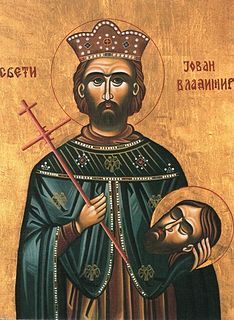 W
WConstantine Bodin was the ruler of Duklja, from 1081 to 1101, succeeding his father, Mihailo Vojislavljević. Born in peaceful times, when the Southern Slavs were subjects of the Byzantine Empire, his father was in 1072 approached by Bulgarian nobility, who sought aid in their revolt against the Byzantines; Mihailo sent them Bodin, who was crowned Bulgarian tsar under the name Petar III joined the short-lived revolt, being captured the following year after initial success. He was freed in 1078, and upon the death of his father in 1081 he succeeded to the throne of Dioclea. Having renewed his acknowledgement of Byzantine overlordship, he soon sided with their enemies, the Normans, which resulted in a Byzantine invasion and his capture. Although he quickly had himself freed, his reputation and influence waned. He was pushed aside into by one of his governors, Vukan, who continued the struggle against the Byzantines.
 W
WDobroslav II was King of Duklja, between 1101 and 1102.
 W
WGeorge I of Duklja or Đorđe Vojislavljević was a King of Duklja from 1113 to 1118, and again from 1125 to 1131. He was a son of King Constantine Bodin, of the Vojislavljević dynasty.
 W
WJovan Vladimir or John Vladimir was the ruler of Duklja, the most powerful Serbian principality of the time, from around 1000 to 1016. He ruled during the protracted war between the Byzantine Empire and the Bulgarian Empire. Vladimir was acknowledged as a pious, just, and peaceful ruler. He is recognized as a martyr and saint, with his feast day being celebrated on 22 May.
 W
WKočapar was the knez or župan of Duklja, a Serbian state, briefly in 1102–03 under the suzerainty of Grand Prince Vukan of Rascia. He was the son of Branislav, the Prince of Duklja. Following Bodin's death in 1108, Bodin's half-brother Dobroslav II succeeded him as king of Doclea. Kočopar, Bodin's first cousin once removed, travelled from Dyrrhachium to Rascia, forging an alliance with Vukan. This alliance would prove worthy in their successful invasion of Duklja in 1102. The battle that ensued at the Morača led to the overthrow of Dobroslav II and the coronation of Kočapar to the throne. Dobroslav was subsequently banished to Rascia and a large part of Dalmatia was pillaged in the process. Vukan gave Kočapar Duklja as a fief. The two would soon brake, with Vukan, sending a squad to Doclea (city), forcing Kočapar to flee to Bosnia and then Zahumlje where he also died.
 W
WMihailo Vojislavljević was the king of Dioclea (Duklja), from 1050 to 1081 initially as a Byzantine vassal holding the title of protospatharios, then after 1077 as nominally serving Pope Gregory VII, addressed as "King of the Slavs". He had alienated himself from the Byzantines when he supported a Byzantine Slavic revolt in 1071–72, after which he then sought to gain support in the West. In 1077 he received a royal insignia by Gregory VII in the aftermath of the Church schism of 1054.
 W
WMihailo II was the King of Duklja from 1101 to 1102. He was the eldest son of King Constantine Bodin of Duklja and Queen Jaquinta. He succeeded his father on the throne of Duklja, but soon lost ground to cousins, pretenders to the throne. left without support, he abdicated and retreated to monastery.
 W
WMihailo III was Prince of Duklja, from c. 1180, or before, up to 1186 or 1189. He was descended from the Vojislavljević dynasty, and also cousin to Grand Prince Stefan Nemanja of Serbia. The Principality of Duklja was tributary to the Byzantine Empire until 1180, when Emperor Manuel I died and Empire plunged into turmoil. By 1186, Byzantine possessions in Upper Dalmatia were overrun by Stefan Nemanja, who also imposed his rule over Duklja. The domain of Prince Mihailo was reduced to the coastal regions around Bar, while the rule over Duklja was given to Vukan, eldest son of Stefan Nemanja. Prince Mihailo was patron of the Archbishopric of Bar, and in 1189 his wife, princess Desislava, was accompanied to Dubrovnik by archbishop Gregory of Bar.
 W
WPeter of Diokleia or Petar was an archon of Duklja in the 10th or 11th century. The only information on him is from a seal found in the 19th century, which is decorated on the observe with a bust of the Virgin Mary holding a medallion of Christ and flanked by two cruciform invocative monograms. The text is in Greek letters, saying ΠΕΤΡ[Ο]Υ ΑΡΧΟΝΤΟΣ ΔΙΟΚΛ[Ε]ΙΑ[Σ] ΑΜΗΝ, i.e. "[Seal] of Peter, archon of Duklja, Amen". The seal shows that although Duklja underwent turmoil in the 9th century, the region still continued under Byzantine rule or at least cultural influence.
 W
WVladimir II was King of Duklja from 1103 to 1113. He was a son of prince Vladimir, the oldest son of King Mihailo I of Duklja, and thus a nephew of King Constantine Bodin. He married a daughter of Vukan, the Grand Prince of Serbia, thereby ending rivalries between the two polities. Vladimir had been appointed the rule of Duklja by his father-in-law Vukan, after the death of his uncle, former King Kočopar, in Zahumlje. He was poisoned in 1118 on the orders of Queen-Dowager Jaquinta, the widow of his uncle, Constantine Bodin. Jaquinta soon appointed her son, George, to the throne.
 W
WStefan Vojislav was the Prince of Duklja from 1040 to 1043. Beginning in the year 1018, he served as a Byzantine governor, until 1034 when he led an unsuccessful revolt that landed him in a prison at Constantinople. He managed to escape and returned home, this time successfully gaining the independence of his statelet and expanding his rule over southern Dalmatia and its hinterland.